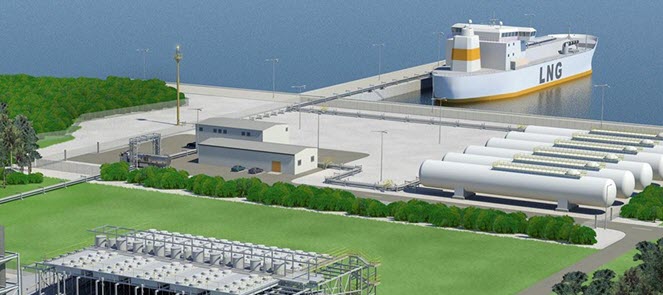1 + 1 = win-win
If your area doesn’t use a large enough volume of LNG to warrant a large terminal, how can you still get in on the LNG action and enable others to take advantage of the flexibility and lower emissions it offers? In many cases, it can be as easy as 1+1.

LNG will play an important role helping to fuel the expected global gas demand growth. The relatively large investment costs required for LNG projects means that, to date, the majority of receiving terminals have been large in size and capacity. But few locations are well suited to such big terminals. So how is this expansion of the LNG network going to be possible or economically feasible?
According to Kari Punnonen, Wärtsilä’s Area Business Development Manager, Oil and Gas Business, Middle East, Asia and Australia, there is a lot of growth potential “in places where the gas infrastructure is underdeveloped but where there is large demand for gas-fired power generation and natural gas for other industrial uses.” These kinds of locations could host a regional storage hub that provides gas directly to consumers, small-scale marine distribution vessels or LNG tanker trucks that can deliver LNG directly to the end user.
The increasing demand for small and medium-sized LNG receiving and regasification terminals has led to consideration of whether a “single purpose” LNG receiving terminal would be a feasible and realistic addition to the local energy mix. One possible configuration of such a Single Purpose Terminal (SPT) is to pair it with a gas power plant, a so-called 1+1 LNG solution.
To test the logistical and financial considerations of this concept, Punnonen has studied the feasibility of pairing three different sizes of LNG-fired power plants, running on simple-cycle, high-efficiency internal combustion gas engines, with various LNG terminal capacities. Each of the power plant options, 50 MWe, 100 MWe and 300 MWe, was evaluated both as a stand-alone gas consumer and linked to additional off-takers with a gas demand similar to that of the power plant itself.
Given his territory of responsibility, Punnonen considered a scenario with Indonesia in mind. To determine the daily LNG volume required by the power plant, he factored in the engine output and fuel consumption under tropical ambient conditions and included a lifetime average degradation of the efficiency between maintenance intervals.
The proposed SPT’s storage tank size was then optimised according to the expected fuel consumption, the location of the LNG distribution hub and the tanker vessel size, factoring in tank minimum reserve and a seven-day emergency reserve in case of any unplanned interruption in LNG supply. The tank’s structure and technical specifications depended on the required capacity and the gas distribution pressure. For example, gas may be supplied at low pressure (8 bar) as fuel to the power plant or at high pressure (for example 50 bar) to pipeline off-takers.
Once these parameters were established, Punnonen simulated possible electricity sales prices, taking into account the fuel costs for the three sizes of power plants, both as standalone gas consumers and with additional gas off-takers, and certain investment and operating costs. The feasibility calculation includes the terminal investment over 20 to 25 years to see how much the cost of the terminal increases both the gas price and produced electricity price.
The fuel gas price also varies depending on the total gas volumes consumed. Additional off-takers in the system bring down the cost per MMBtu and are therefore important to the economics of the project. Punnonen notes that even a “satellite concept” of several small power plants in the area that draw from the same LNG terminal is a feasible way to increase gas consumption. In that case, smaller LNG carriers can do a “milk run” to fill tanks at each smaller power plant.
So do the economics add up for LNG-based small and mid-sized power generation? Punnonen believes that, even at its highest, the “terminal effect” (of factoring in the cost of the investment, operations and maintenance for the terminal) only increases the power tariff by about 15 to 20%. In places where need and demand are high, the 1+1 solution is a viable one. And although the terminal economics are case-specific, there are several benefits that such projects can expect regardless of their size.
LNG allows for more diversity and security in the local energy mix, and its price relative to energy content is favourable when compared with other fossil fuels. Perhaps most importantly to the local population, LNG significantly reduces SOx, NOx and CO2 emissions when replacing coal or oil for power generation.
“This combined 1+1 LNG solution, including the power plant and LNG terminal, is unique and differentiates us from competitors,” Punnonen says. “When doing this development type of work, it’s an advantage when we can do the full package – both in the ease of logistics, which includes the ability to bring in a variety of Wärtsilä equipment, and from a financial investment perspective.”
This article was first published on Twentyfour7, Wärtsilä’s stakeholder magazine.
By :Wärtsilä